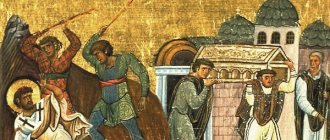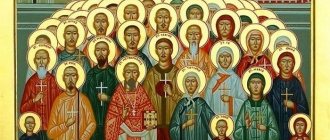The tender and melodious female name Anastasia first appeared in Ancient Greece from the word “resurrected.” Previously, only representatives of the nobility were called this beautiful name, but later it became popular in peasant families. In Russia, girls are still called by this name.
Pronunciation of the name Anastasia in different countries of the world: England - Enestecia, Germany - Anastasia, France - Anastasi, Spain - Tachita, Portugal - Anastasia, Italy - Nastaja, Belarus - Anastasia, Czech Republic - Anastasie, Bulgaria - Anastasiyka, Ireland - Annstas, Scotland - Annstis.
Diminutive form of the name: Nastya, Nastyushka, Ana, Anastasyushka, Anastasichka, Nastya, Naska, Nastyushenka, Nastyusha, Nastenka, Anastasenka, Aska, Asya.
Patron saints of Anastasia
Famous saints named Anastasia:
- Anastasia Pattern Maker. Honored on January 4th. Born into a family of a secret Christian and a pagan. She was married to a pagan and brought clothing, drink and food to imprisoned Christians. She was burned at the stake in 304 for belonging to the Christian faith.
- Anastasia Patrika. Venerated on March 23. Born into a noble family, after the death of her husband she founded a monastery near Alexandria. After which she settled in a remote cave, where she spent the last years of her life in prayer.
- Anastasia Rimskaya. Venerated on April 28. Born into a noble family, after the death of her parents she was raised in a Christian community. For refusing to marry a pagan, she was subjected to severe bullying, after which she died.
- Anastasia Romanova. Venerated on July 17th. Grand Duchess, daughter of the Russian Empress Alexandra Feodorovna and the All-Russian Emperor Nicholas II. Killed by the Bolsheviks on July 17, 1918.
History of the name Anastasia
Anastasia is a feminine name, the feminine form of the masculine name Anastasy (Anastas). Translated from ancient Greek - “resurrection” or “returned to life.”
The most common diminutive form of the name Anastasia in Russian is Nastya.
Other derived forms: Nyusya, Nastenka, Nastena, Tusya, Styura, Stasya, Tasya, Asya.
The diminutive form Nastenka became especially popular after the release of the film Morozko.
Angel Anastasia Day 2021 / photo UNIAN
Fate
Little Nastyushka is growing up as a very restless, curious girl. Parents need to keep an eye on her. He makes friends easily, will always come to their aid, and loves to invent games. She loves to cook with her mother and help her with housework, but Nastyusha is too lazy to clean up her things; this quality may remain with her into adulthood. Despite the fact that Nastyusha has many friends around her, there are no close ones among them due to her inability to accept other people's truth and superiority. Nastyusha is growing up to be a very beautiful and attractive girl, who is fully aware of this and loves to preen herself and twirl in front of the mirror.
Restless Nastyushka studies well at school only in those subjects that are personally interesting to her. Likes to participate in school productions and performances. Thanks to her grace, she dances well. If she attends a dance school, she can become a famous dancer. During adolescence, Nastya often falls in love, is popular with boys, but does not let them get close to her. Because of her excessive gullibility and kindness, she is often deceived and betrayed. Anastasia will forgive the offender, but she will not let him into her life anymore.
As an adult, Anastasia charms those around her with her kindness, unforgiving nature, easy-going character, and ability to communicate and make friends. He always dresses with taste, skillfully combining clothes, and takes care of his hair and skin condition. It’s almost impossible to catch Nastya unkempt. Adult Anastasia is very suggestible and easy to move. Anastasia likes to give original gifts to her friends and family, which she carefully selects. There are still many friends around her, but there are no close ones among them. Anastasia will never do harm to another person on purpose, she will not do a bad thing.
Characteristics of the birthday girl Anastasia:
From the ancient Greek name Anastasios - “resurrected” - “resurrecting bride”, “reviving life”.
This name was born in Ancient Greece at the dawn of the formation of its statehood among the warlike Amazons - female warriors who lived in the Black Sea steppes, as well as at the mouth of the Borysthenes (modern Dnieper) - the ancestral home of the ancient Russians. And if we look even further into the depths of centuries, we will find in West Semitic mythology the name Anat, similar in meaning and sound, to the goddess of the hunt, warrior maiden, sister and beloved of the eternally dying and annually resurrected god of fertility - Balu.
In ancient Greek mythology, Anat is always mentioned with the epithet “bride of the people.” In Ancient Egypt, this goddess was identified with the goddess of love and fertility, whose name had a similar semantic meaning to the name Anastasia - Astarte. Every spring Astarte revived (resurrected) the earth and filled it with divine power and fertility. So, obviously, the name Anastasia is far from being of a simple (not human) kind, but of a divine kind. Therefore, this name contains the features of its divine sisters of the same name.
So, classic Anastasia is kind, smart, beautiful, gentle, fair. She will always find the right – warm and kind – word for any person. She also knows how to calmly and quietly prevent a quarrel and settle a controversial matter. For the sake of peace in the family and for the good of the children, Anastasia is ready to make any sacrifice. She always gives in to her mother-in-law, husband, and daughter-in-law, and helps the poor as much as she can. Don’t smile skeptically: they say, there are no such things. Indeed, not all Anastasias are like that, but many of them are like that.
Modern (earthly) Anastasia is a typical choleric person with a very quick reaction. She cannot sit in one place for a minute. Therefore, Anastasia’s symbol is the carrier pigeon, so life is easy with her. Her mood constantly changes - she either laughs or cries. Or she sits silently for hours in deep depression, completely lost in her inner world.
Sometimes Anastasia looks too self-confident, but this is just an external impression. In reality, she is not capable of any action, much less decisive. She is constantly excited, as a result of which her desires are constantly changing. And since Anastasia reacts violently to everything and acts impulsively, it is not at all easy to calm her down. To do this, you need to make a lot of effort and pay a lot of attention to her
Anastasia, of course, is not always so stunning. Basically she is more or less calm. Parents need to constantly monitor Anastasia’s behavior, but in such a way that she does not get the impression that she is being watched and that her freedom is being limited. After all, Anastasia has a good intellect, she quickly grasps everything, analyzes and draws appropriate conclusions, which are usually correct. And if something doesn’t work out very well for her, then she immediately becomes despondent. True, not for long - today she is anxious, and tomorrow she is full of joy.
Anastasia likes it when there are a lot of people around her, friends, whom she constantly changes. Anastasia understands that she is violating moral principles by betraying them. However, she cannot do anything about herself and her penchant for violent adventures.
Anastasia is a carefree and reckless nature, which sometimes leads to accidents, especially when she is driving her own car. As a result, Anastasia often ends up in the hospital trauma department with broken legs. Her kidneys also bother her from time to time. As for her professional activities, among Anastasia there are many flight attendants, journalists, and sales representatives of large companies (managers). So Anastasia’s carrier pigeons lead a very intense and hectic life, including a family life. You will never get bored in their company, especially since Anastasia themselves have great charm. Talisman – emerald, fire opal.
Career
Friendly and gentle Anastasia will not be able to become a careerist who goes over the heads of her rivals. She won’t make a tough and strong-willed boss either; it’s better for her not to create her own business, there’s a high risk that it will soon burn down. Anastasia chooses her profession based on her talents; she is little concerned about the material side. It will be great if the profession is related to art and communication with people, where she will feel like a fish in water. For example, she will make an excellent designer, fashion designer, psychologist, teacher.
Character traits
The character of each Nastya can be judged by her name. Girls named this way are distinguished by their willpower, changeable moods, they are trusting, kind and hardworking. It won’t be possible to persuade someone to do a bad deed - every Nastya always knows what she wants. These qualities need to be developed in childhood, then in adulthood they will develop into better personal qualities. They say that the closer the date of birth and name day, the stronger these qualities are manifested.
Nastya's mood is changeable: one minute she can be cheerful, and the next she can become extremely serious. Character traits are also changeable: from kind and open, she can become closed and strict. Basically, such changes are associated with the uncertainty present in any life situation. When Nastya feels some kind of misunderstanding towards herself, she tries to be on her guard.
Another area of uncertainty concerns self-realization. Not all girls are sure whether they chose the right profession, whether they married the right person, or what they could do to make life different. To understand the subtleties of character, you can study the word “uncertainty” itself. Avdiysky V.I. and Bezdenezhnykh V.M. joined forces in scientific work devoted to the precise interpretation of uncertainty.
The intellect of the bearers of this name is quite developed. It is not reflected in grades for subjects at school - the information in Nastya’s head is assimilated only that which will be necessary in life. Thanks to their attentiveness and observation, many Nastyas become analysts.
The only thing that doesn't change with age is imagination. This is what helps Nastya become the life of the party. Often even the choice of profession depends on the imagination. All professions related to communication, understanding or compassion are ideally suited. This could be either an artist or a kindergarten teacher. A sedentary lifestyle is not suitable, because every Nastya is active and energetic by nature.
Anastasias are always open to communication, they are very friendly and know how to keep other people's secrets. They are excellent conversationalists and love having a lot of friends around. In family life, only if the spouse is strong and self-confident, Anastasia will become a faithful, loving and caring wife. The main character traits become less obvious if the girl calls herself Nastya.
The name Anastasia itself has very strong energy. It perfectly combines both vital and divine principles, as well as enormous willpower and life potential. The main thing is to direct this data in the right direction, then they will be Nastya’s faithful companions throughout her life.
Love
If Anastasia falls in love, it will be for a long time. For her, no one exists except the object of her adoration; she gives herself all to him. In love relationships, Anastasia is often unpredictable, emotional, and passionate. Since Anastasia falls in love immediately and strongly, she does not notice the man’s shortcomings, which is why she then suffers greatly. She should listen to the words of close people who honestly warn about the shortcomings of her chosen one.
What to give a girl on Angel's Day?
As a gift, you can prepare a small souvenir, for example, a box of chocolates and a bouquet of flowers. You can also go to church and buy an icon with the name Anastasia and congratulate your friend on her name day.
It is worth noting that not all girls are currently religious. Therefore, when choosing a gift, be careful.
Below we have compiled a list of small gifts that can be given to Anastasia on Angel’s Day:
- - photo frame with a picture of a girl;
- - a table clock;
- - jewelry box;
- — keychain or key holder;
- - a bouquet of flowers from soft toys.
Prayer text
“Oh, long-suffering and wise Great Martyr of Christ Anastasia! Your soul is in heaven at the Throne of the Lord, but on earth, by the grace given to you, you perform various goals: looking mercifully at the people ahead, praying before your relics, asking for your help: simple To the Lord, your holy prayers for us, ask on the left for our sins, for the sick, healing, for the grieving, for the needy, first aid: I prayed to the Lord, may he give us all the Christian end and a good answer at His Last Judgment, so that we may be worthy, together with you, to glorify the Father, the Son, and the Holy Spirit forever centuries. Amen."
What do they ask for and what does it help with?
Throughout her earthly life, the holy martyr helped prisoners suffering in prison for the faith of Christ, therefore, in front of her icon they pray for those who are unjustly convicted, are in prison, for those who are under investigation. The convict himself or his relatives can read a prayer in front of the icon.
Calm the fear
The icon of Anastasia the Pattern Maker instills confidence and strengthens faith in the best. People turn to her for help when life is full of problems. People turn to the saint on the eve of a trial; she gives strength and helps to avoid injustice. The Great Martyr helps pregnant women cope with the fear of childbirth. Women turn to her when they want an easy, quick birth.
Don't be afraid of humiliation
Anastasia suffered a lot of suffering and humiliation from her husband, so victims of oppression and injustice pray before her image.
Cure from diseases
During her earthly life, the saint cured various ailments. Prayer before the icon of the Great Martyr helps with bodily illnesses.
Wounds heal quickly
The Holy Pattern Maker healed the prisoners’ wounds inflicted during torture. Believers who have undergone serious surgery or have been injured turn to her.
Eliminate emotional distress
By turning to the image in prayer, you can ask for a cure for mental illness, liberation from difficult thoughts and experiences. The saint helps to cope with negativity and strengthens faith in the Lord. Prisoners turn to her if they feel that their strength is running out.
Orthodox Life
On January 4, the Orthodox Church remembers the Holy Great Martyr Anastasia the Uzor-Resolver. Read about the history of one of the most popular female names in Russia and Saint Anastasia in our material.
The origin of the name “Anastasia” is associated with the ancient Greek language and translated means “resurrection”, “return to life”. There is also a paired male name with the same meaning, but it is not widespread in Russia.
The popularity of a female name is evidenced by Orthodox calendars. In the calendar of the Russian Orthodox Church we will meet 15 saints with this name, most of them (10 people) are martyrs. One Venerable Anastasia is the mother of Saint Sava of Serbia, one Alexandrian hermit, who, according to legend, lived in a monastery under the name Anastasia - a eunuch, one passion-bearer - the daughter of the last Russian Emperor Nicholas II, another nun and Saint Anastasia of Latria.
The list of saints with the paired male name Anastasius is no less impressive - it includes 20 Orthodox ascetics from different countries - from Egypt to Persia, Bulgaria and Russia.
Name Anastasia in different languages
The euphonious, sonorous name has long been loved not only in Russia, but also abroad. In Britain we will meet Stacy (Stacy), in Germany - Nastja, Anastasija (Anastasia), in France - Anastasi, Naste (Anastasi and Naste), in Slavic languages there are variations of our Anastasia. In general, “Nastya” was loved throughout Europe - from warm Greece to cold Russia. Anastasia can be found even in China or Korea.
Nastya, Nastenka and other abbreviated and diminutive forms of the name Anastasia
A rare Russian personal name can compete with Nastya in the variety of diminutive forms. Tasya, Stasya and even Asya - all these forms in the modern dictionary of personal names are associated with the familiar Nastenka, and there is also Anastasyushka, Anastaska, Nastasya, Nastya (Nasta), Nasya (Nasa), Nata, Naya, Nayusya, Nyusya, Nastena, Tyona, Nastya, Nastusya, Tusya, Nastyulya (Nastulya), Nastyunya (Nastunya), Nastyura, Styura, Nastyukha, Nastyusha, Nastyakha, Stasya, Tasya, Taya, Asya, Asyusha, Susha, Asyuta, Syuta. If a person needs to turn to some “Anastasia Ivanovna”, then it is worth remembering that this name has the same forms of genitive, dative and prepositional cases.
Male name Anastasy
A male name with the same ancient Greek root is not often found in Russia. Most people will only remember Anastas Mikoyan, a Soviet leader with a short form of the name "Anastasy".
Mikoyan is now most often talked about in connection with the meat processing plant of the same name. In the 30s, Anastas Ivanovich was the People's Commissar of the food industry and created Soviet fast food. In particular, it was not without his participation that the famous “Doctor’s” sausage and the infamous “fish days” in Soviet canteens were invented.
Few people know that Anastas Mikoyan studied in 1916 at the Theological Academy located in the Etchmiadzin Monastery.
In other countries, the male name Anastasius was more common, as evidenced by four Popes and two Byzantine emperors.
Pope Anastasius IV, who lived in the 12th century, went down in Church history as the bishop of Rome with one of the shortest tenures in the cathedra of the eternal city. He was Pope for a little more than one year - from July 12, 1153 to December 3, 1154, but during this time he transferred the relics of Saint Helen Equal to the Apostles - the mother of Constantine the Great was transferred to a modest shrine, and the luxurious antique sarcophagus, where the remains of the saint had previously been kept, he prepared for myself. In this sarcophagus he was buried in the crypt of St. Peter.
But among the female celebrities there was a sea of tennis player Myskina, Dostoevsky’s heroine Nastasya Filippovna, the woman hero Nastasya Mikulishna, the daughter of the last Russian Emperor Nicholas - this is just a short list of historical figures and literary characters with the name Anastasia. Anastasia was also the daughter of Prince Yaroslav the Wise of Kyiv - the Queen of Hungary. Her image can be found on the fresco of St. Sophia Cathedral in Kyiv. The fate of the queen herself was very difficult - she and her children had to flee from Hungary to Bavaria. One of her sons argued with Anastasia Yaroslavna and even raised his hand against her.
Name Nastya
In the new millennium you will rarely find a school, institute or work where there would not be a girl or girl Nastya. In 1978-1981, 31 babies out of a thousand were named Anastasia, and this name was only in 11th place. But then the rapid growth of popularity began:
In the 80s of the last century, Yuri Antonov sang “Anastasia”:
The distance of life opened wide to me, You appeared, more beautiful than spring. The birds in the sky chirp: “Nastya,” the grasses echo: “Anastasia.” Happy am I, conquered by the power of these cornflower-blue eyes. Lips whisper tenderly: “Nastya”, Heart echoes: “Anastasia”.
Since then, the popularity of the name has been constantly increasing.
In 2011, 53 out of a hundred newborn Muscovites were named Anastasia. Several times over the past 15 years, this name has come out on top in popularity. In 2013, she was second, losing the championship to Maria in Moscow.
Anastasia's birthday
Rarely the owners of the name can boast of such an abundance of patron saints. Nastya can celebrate name day on January 4, March 23, April 5, April 28, May 10, June 1, 5 and 9, July 4, July 17, August 10, November 11 and 12, December 17.
Saints named Anastasia
In the Orthodox calendar you can find at least fifteen saints with this name; let’s try to tell you a little about the most famous ascetics.
Among the ascetics with the name Anastasia, the first place in popularity will be the patron saint of prisoners - the holy great martyr Anastasia the Pattern. Her earliest life that has come down to us was compiled in the 6th century, so we know almost nothing about the life of this saint.
The Great Martyr Anastasia suffered in 304 during the cruel persecution of Emperor Diocletian. This was an emperor who wanted to save the crumbling Roman Empire. As the Christian writer Lactantius notes in his essay “On the Death of Persecutors,” persecution for faith was total: “All people, (without distinction) of gender and age, were driven to the stake; and there were so many of them that they were surrounded not individually, but in crowds, and were set on fire; the servants were drowned in the sea, with a millstone tied to each of their necks. . No less wild persecution affected the rest of the people, because the judges, scattered throughout all the temples, drove everyone to sacrifice... The dungeons were full, unheard-of types of torture were invented, and, no matter what case the trial was carried out, in secluded places and in front of the tribunal they were located altars, so that those involved in litigation first make sacrifices and, under such circumstances, speak out about their affairs.”
Anastasia fearlessly visited Roman prisons and helped the sufferers. After the death of her teacher, she traveled through the provinces of the Roman Empire, where persecution raged. She visited Greece and Macedonia, alleviated the suffering of prisoners - brothers in faith. She was soon captured and, as a Christian, sentenced to be burned at the stake.
The Great Martyr was widely revered in the West already in the 4th century. Her honest head was in the monastery of St. Anastasia near the Greek city of Thessaloniki, but on the night of April 22-23, 2012, unknown persons stole the relics of this ascetic.
Memorial Day of the Great Martyr Anastasia is January 4.
Anastasia the Roman or the Roman
In 250 or 256 in Rome, after prolonged torture, another martyr named Anastasia was beheaded. Becoming an orphan at the age of three, the noble girl was raised in a Christian community near the eternal city. She was very beautiful, and at the age of 20, rejected suitors handed her over to the mayor Prov. He demanded that she renounce Christ and marry some patrician. Anastasia refused, the enraged persecutor ordered her to be tortured naked in front of the crowd, but the saint continued to glorify the Savior and was eventually executed. Her body was found by local Christians and buried in the outskirts of Rome.
Memorial Day of Anastasia the Roman is November 11.
Anastasia Rimskaya
Apparently Rome had a special attraction for martyrs named Anastasia. After the sermon of the holy apostles Peter and Paul, one resident of the eternal city accepted the new faith. During Nero's persecution, Anastasia and her friend Vasilisa buried the bodies of dead Christians. After torture, she was beheaded as a Roman citizen in 68. (Roman citizens, as we can learn, for example, from the Acts of the Apostles, had a number of privileges: they could demand the trial of the emperor, so the Apostle Paul was taken to Rome, and he himself spent several years in prison awaiting trial. Roman citizens could not shameful executions were used (crucifixion or being eaten by wild animals in the arena), so they were executed with the sword.
The ancient historians Suetonius and Tacitus briefly report on the reasons for Nero’s persecution of Christians. The text of the latter in the XV book of the Annals connects the persecution of followers of the new faith with the great fire of Rome and the emperor’s desire to shift the blame to Christians: “So Nero, in order to overcome rumors, found the guilty and put to the most sophisticated executions those who, with their abominations, had brought upon themselves universal hatred and whom the crowd called Christians. Christ, from whose name this name comes, was executed under Tiberius by the procurator Pontius Pilate; suppressed for a while, this harmful superstition began to break out again, and not only in Judea, where this destruction came from, but also in Rome, where everything that is most vile and shameful flocks from everywhere and where it finds adherents. So, first those who openly admitted that they belonged to this sect were captured, and then, on their instructions, a great many others were caught not so much in the villainous arson as in hatred of the human race. Their killing was accompanied by mockery, for they were dressed in the skins of wild animals so that they could be torn to death by dogs, crucified on crosses, or those doomed to death by fire were set on fire at nightfall for the sake of night illumination. Nero provided his gardens for this spectacle; At the same time, he gave a performance at the circus, during which he sat among the crowd dressed as a charioteer or drove a team, participating in a chariot race. And although the Christians were guilty and they deserved the most severe punishment, yet these cruelties aroused compassion for them, for it seemed that they were being exterminated not for the sake of public benefit, but as a result of the bloodthirstiness of Nero alone.”
The relics of the holy martyr Anastasia are in Rome.
Memorial Day for Anastasia Rimskaya is April 28.
Anastasia Romanova
The youngest daughter of the last Russian Emperor Nicholas II was born on June 18, 1901. She was the fourth child in the family and was educated at home from the age of 8. The curriculum included French, English and German, history, geography, the Law of God, natural sciences, drawing, grammar, arithmetic, as well as dance and music.
Anastasia Nikolaevna did not like grammar, wrote with many errors, and called arithmetic “beastly.” At the same time, Anastasia had a very kind character - she loved pets, adored candies and sweets and willingly shared them with others.
Anastasia’s teachers said that the girl had an easy character. She loved to play hide and seek, lapta, and serso (a game in which you need to throw rings onto a peg). She willingly climbed trees, loved to weave flowers into her hair, and was tenderly attached to her brother Alexei, spending whole days with him during attacks of his illness.
Growing up, during the First World War in a hospital, she gave concerts for the wounded and helped her sisters and mother in their ministry as Sisters of Mercy.
Together with the rest of the royal martyrs, she was shot in the basement of the Ipatiev House on the night of July 16-17, 1918.
St. Anastasia's Memorial Day is celebrated on July 17 along with other members of the royal family.
The legend of the rescue of Anastasia Romanova
After the execution of the royal family, the story of the miraculous rescue of Nicholas II’s youngest children, Anastasia and Alexei, became widespread. The most famous false Anastasia was Anna Anderson, who claimed that she was saved by a soldier with the musical surname Tchaikovsky. The impostor was quickly exposed, and the final point in this matter was put to two genetic examinations carried out in 1995 and 2011
Icons of Anastasia
On the icons of saints you can often find objects associated with their feat.
The Great Martyr Anastasia the Pattern-Resolver is depicted with a cross (a symbol of martyrdom) and a bottle of medicinal oil, with which she alleviated the suffering of prisoners.
Anastasia the Roman is often dressed in monastic robes as a symbol of chastity.
The iconography of Saint Anastasia Romanova is distinguished by some portrait similarities. The saint holds a cross in her hands as a symbol of suffering. On the most common icon of the royal martyrs, on Anastasia’s head you can see a crown or diadem as a symbol of the royal
authorities.
THOMAS










